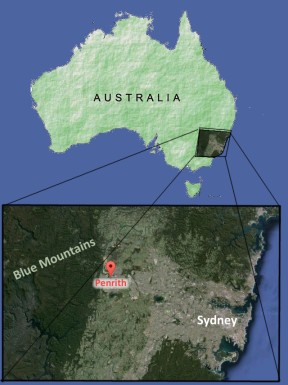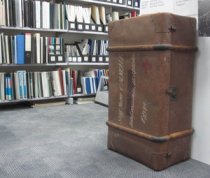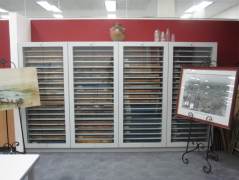Penrith  is a small city on the Cumberland Plain, located in the shadows of the stunning Blue Mountains. Down in the plains, roadside signage is a testament to the harsh environment: at frequent intervals drivers are warned of the daily fire danger rating and informed of the nearest flood evacuation route. Both natural disasters are common occurrences, though far better controlled now than they were in the past. Australia is clearly a tough place, and it’s a wonder to me that their early settlers not only survived, but built a thriving community. Perhaps the hardships explain why the locals value their local history as much as they do…
is a small city on the Cumberland Plain, located in the shadows of the stunning Blue Mountains. Down in the plains, roadside signage is a testament to the harsh environment: at frequent intervals drivers are warned of the daily fire danger rating and informed of the nearest flood evacuation route. Both natural disasters are common occurrences, though far better controlled now than they were in the past. Australia is clearly a tough place, and it’s a wonder to me that their early settlers not only survived, but built a thriving community. Perhaps the hardships explain why the locals value their local history as much as they do…
The Research Room
In addition to offering typical public library services—collections, internet access, programs, etc.—the Penrith Public Library also is home to a truly impressive local studies collection. The Research Room contains a comprehensive collection of materials relating to the region’s people and history. “Comprehensive” means separate collections for local history, photographs, family history, government information, and technical documents relating to the environment and urban planning in the area. The library also several special projects which aim to make their newspaper and historical photos available in a national database maintained by the national library. For a small library system serving a population of just 186,937 residents, this amazing effort has been made possible by the perfect storm of a dedicated individual, political support, and government funding. Starting in the 1980s there was a surge in interest in local and family history. In response the state of New South Wales decided to give political and financial support in these areas at their archives and in public libraries. The state still has many dedicated “local history librarian” positions.
The person responsible for the research room is not a local history librarian, but is a member of the local family history society. She is passionate about helping people connect with the past and preserving all possible local history. A few of the projects she leads are:
Support for history students
Some local students undertake a history project where they study the biography of a local man or woman who served in the First World War. To support these projects, the staff at the library have created profiles for each known local who was part of the war effort, complete with copies of service records, medals, newspaper articles, and, where relevant, a picture of their grave from the Commonwealth War Graves Commission. The next phase of the project will be to make the contents available online where links can take the students from the written summary directly to the source information.
Digitizing The Nepean Times
When it was clear that the Australian Newspapers Digitisation Program would not get around to digitizing Penrith’s local paper for many years, the library decided to fund the project itself. Once all eighty years of the paper had been scanned, the files were made available on Trove, the National Library of Australia online resource portal. Not satisfied with this progress, the library has organized volunteers to read through the digitized versions line by line to correct the text created by OCR (character recognition) software.
Local photo history
One more project relying on volunteer hours is the photo archives. The library is digitizing historical photos as the budget permits, while volunteers catalogue them according to an in-house system. The pictures are currently available in binders in the library and on the council website in a section called Penrith in Pictures. They will eventually also be available on Trove, which provides a more advanced database and a far larger audience than a small public library system could supply.




